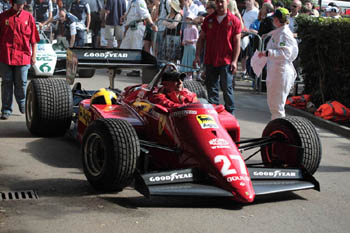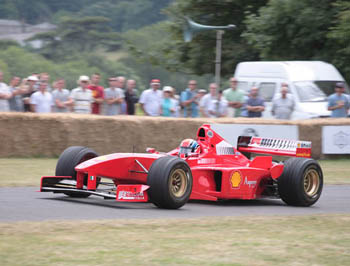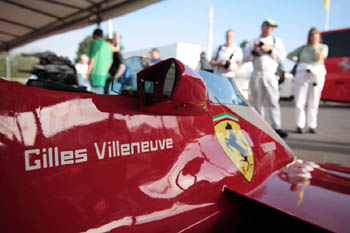

 |
|
Ferrari is history's most prolific
constructor of F1 single-seaters and at the
Goodwood Festival of Speed each year a
plethora of slippery its red machines take
to the "hill" to wind back the clock and
relive past glories that are remembered by
every generation of visitor. Photos: Johnny
White. |
|
 |
|
|
|
Ferrari is history's most prolific
constructor of F1 single-seaters and at the Goodwood
Festival of Speed each year a plethora of slippery its red
machines take to the "hill" to wind back the clock and
relive past glories that are remembered by every generation
of visitor. This year's edition was to be no different, and
from the 312/68, which graced the world's most challenging
race tracks more than 40 years ago, to last year's
constructors' title winning F2008, the Maranello-born
machines muscled all pretenders out of the limelight in the
F1 paddock.
Scuderia Ferrari, like most of the current F1 grid, is
officially represented each year, bringing its latest
machines to thrill the crowds, and for this edition it
demonstrated the 2008 F1 Constructors' Championship-winning
F2008 car, which was driven by its Official Test Driver Marc
Gené throughout the weekend. The F2008 also took the
drivers' title fight right up to the wire last year with
Felipe Massa agonisingly missing out on the championship in
the final few bends of the last race of the season on his home turf in
Brazil, the crown going instead to the McLaren team's Lewis
Hamilton.
At Goodwood, chronologically, the
line-up of F1 cars to have emerged from Maranello kicked off
with the 312/68 which was built in 1968. Featuring a
3.0-litre V12 with 48 valves and 410 bhp it was fast but
unreliable, and in the hands of Chris Amon it collected four
pole positions but wasn't able to muscle its way into the winners'
circle. Other notable drivers to have been behind the wheel
of this machine include Derek Bell. It was entered by
Jean-Francois Decaux at Goodwood in Class 08: Classic
Grand Prix Cars - When F1 Cars Went From Front-Engined To
Rear Engined, High To Low, Narrow To Wide. Another
single-seater
of great note to enthusiasts of Italian racing cars be entered in this class was the famous Maserati
250 F.
Two evocative
representative of the Prancing House captured memories in
Class 09: Evolution Of The F1 Car - A Dramatic Display Of
Two Decades Of Evolution Within F1 Racing, the 312T3 and
126C4. The 312T3 was built for the 1978 F1 season but wasn't up
to the pace set by Colin Chapman's ground-breaking Lotus 79.
However it still took five wins, including Gilles
Villeneuve's memorable maiden win in Canada. At Goodwood it was
entered by Ten Tenths Motorsports Ltd, and to huge acclaim
from the passionate crowds lining the Festival's hillclimb it was driven
with great aplomb by none other than former Irish Ferrari F1 star
Eddie Irvine. The 126C4, meanwhile, was raced during the 1984
season and fitted with a 1.5-litre V6 turbocharged engine.
The car in action at Goodwood, chassis 072, was driven by Michele Alboreto and updated mid season to Modifica 2
specification. Despite having 850-bhp it struggled against the
in-form McLaren MP4/2s that year although it still wrapped up second place in the
constructors' standings. At the Festival the 126C4 was
entered by L Prandina and demonstrated up the "hill" by Mezario
and Cantarella. Other notable F1 cars in this class included
the fast-but-fragile Renault RE30B (1982) and the
slow-but-fragile Beatrice-Lola THL1 (1985).
The F300 is a
significant single-seater car from Ferrari's long history as it
was the first of the highly successful red machine of the Ross Brawn/Rory Byrne era.
Built for the 1998 F1 season it took six F1 wins in the
hands of Michael Schumacher but narrowly missed out on the
title at the very last round, with the championship going to
McLaren's Mika Hakkinen. Entered by Pierangelo Masselli in
Class 10: High Tech Grand Prix Cars - Aerodynamics, Active
Suspension And Complex Computing Take Hold In F1 it took
its place in the paddock alongside another long forgotten,
but in this case
utterly hopeless Italian F1 car, of that era, the 3.5-litre
W12-engined Life B190 from 1990, as well as the
Benetton-Ford B192 (1992) and the Leyton House-Judd CG901B
(1990).
|
|
|